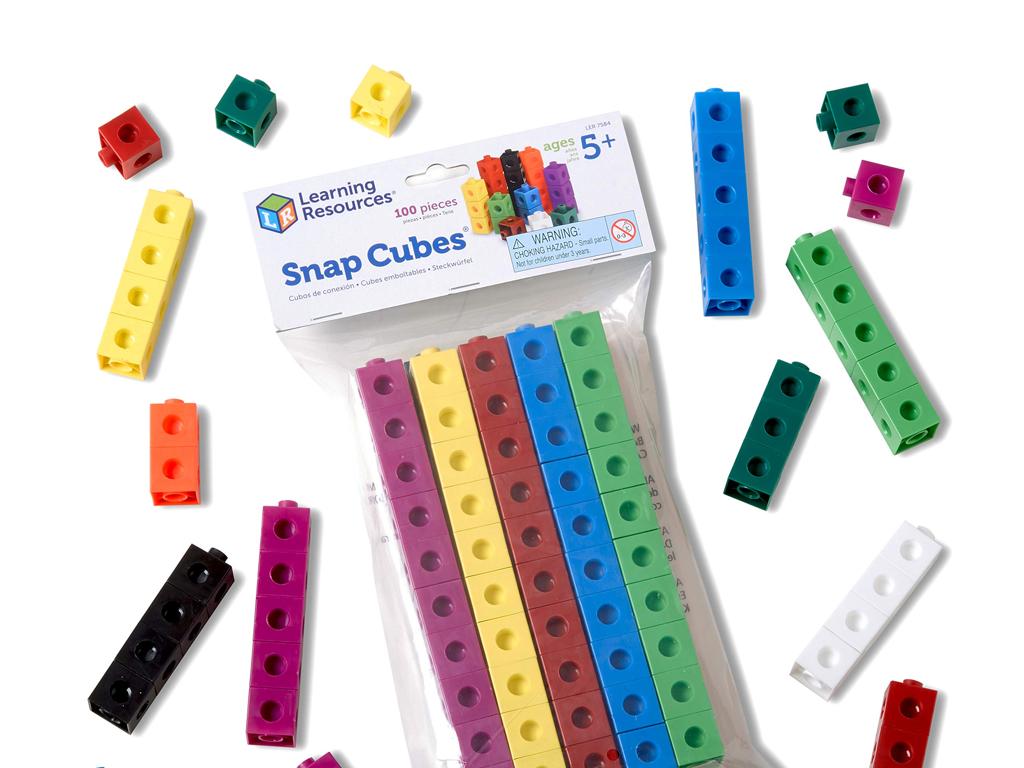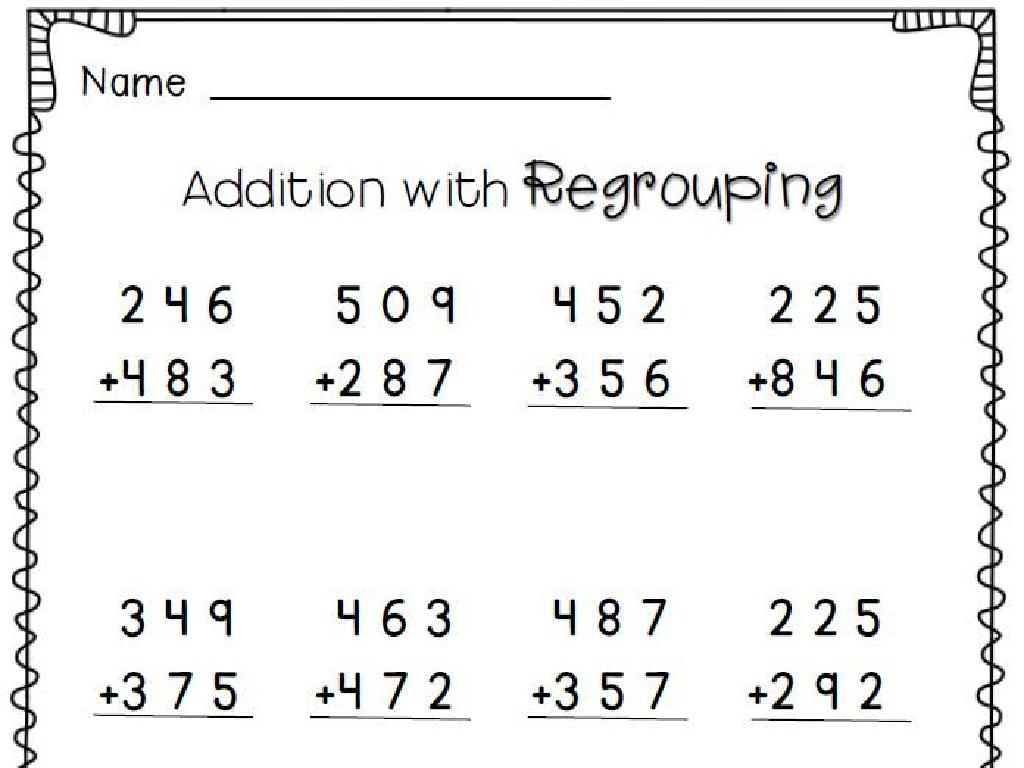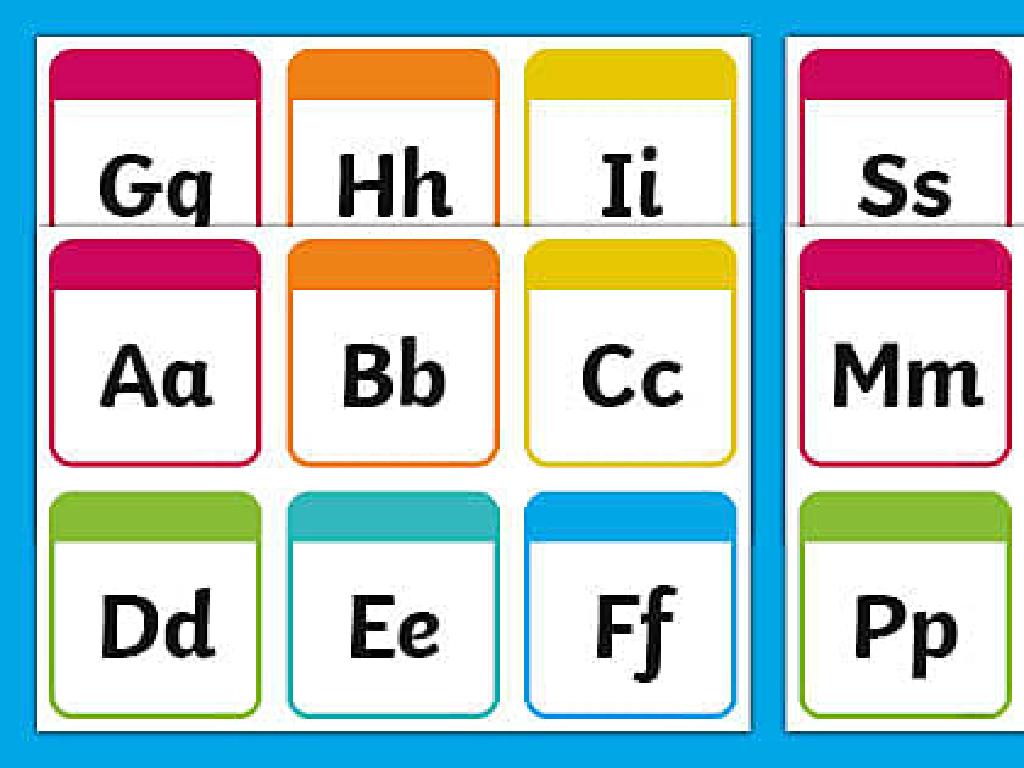Write Variable Expressions From Diagrams
Subject: Math
Grade: Eighth grade
Topic: Expressions
Please LOG IN to download the presentation. Access is available to registered users only.
View More Content
Introduction to Variable Expressions
– Understanding algebra’s language
– Algebra uses symbols to represent numbers and operations.
– Defining variable expressions
– Expressions include numbers, variables, and operations.
– Variable expressions in real life
– Used in budgeting, coding, and science experiments.
– Practice with diagrams
– Translate diagrams into algebraic expressions.
|
This slide introduces the concept of variable expressions, a fundamental aspect of algebra. Begin by explaining that algebra is like a language with its own rules, using symbols to represent numbers and operations. Define variable expressions as combinations of numbers, variables (letters representing unknown values), and mathematical operations. Illustrate how these expressions are applicable in everyday life, such as in budgeting (calculating expenses), computer programming (writing code), and conducting scientific experiments (measuring changes). Conclude by showing how diagrams can be translated into variable expressions, which is a critical skill for solving algebraic problems. Encourage students to think of other areas where variable expressions might be used and to practice writing expressions from various diagrams.
Understanding Variables in Expressions
– Define a variable in math
– A symbol that represents a number
– Examples of variables in use
– x in 2x + 3, y in y/4 – 5
– Variables as unknown quantities
– Variables can stand for numbers we don’t know yet
– Writing expressions with variables
– From diagrams, translate parts into variable expressions
|
This slide introduces the concept of variables within the context of algebraic expressions. A variable is a fundamental element in algebra, acting as a placeholder for numbers that may vary or are not yet known. Provide clear examples of variables in expressions, such as ‘x’ in ‘2x + 3’, where ‘x’ can represent any number. Emphasize that variables allow us to write expressions that can solve for unknown quantities. Encourage students to practice writing expressions from diagrams, which is a visual way to understand how variables fit into mathematical statements. This skill is crucial for solving equations and understanding functions.
Understanding Diagrams in Variable Expressions
– Diagrams as visual problems
– Diagrams translate problems into visual format, making it easier to understand.
– Components of a diagram
– Identify different parts: variables, constants, and operations.
– Connecting diagrams to math
– Use diagrams to grasp abstract math concepts like algebra.
– Formulating expressions
– Create algebraic expressions from visual elements.
|
This slide aims to help students grasp how diagrams can simplify the process of understanding and solving mathematical problems. Emphasize that diagrams are tools that represent variables, constants, and operations in a visual context, which can be particularly helpful in algebra. Encourage students to break down diagrams into their constituent parts and see the correlation between these parts and mathematical concepts. Finally, guide them in translating these visual cues into variable expressions, reinforcing their algebraic thinking skills. Provide examples of diagrams and work through them together to formulate expressions.
Writing Expressions from Diagrams
– Identify diagram variables
– Variables are elements that can change value.
– Determine math operations
– Look for addition, subtraction, multiplication, division signs.
– Translate to an expression
– Convert visual info into algebraic expressions.
|
This slide is aimed at teaching students how to write variable expressions from diagrams. Start by identifying the variables represented in the diagram. These could be quantities like the number of objects or measurements. Next, determine the mathematical operations shown or implied in the diagram, such as sums or products. Finally, guide students to translate the visual information from the diagram into a variable expression. For example, if a diagram shows several groups of objects, students might write an expression to represent the total number of objects using multiplication. Encourage students to practice with different diagrams and to check their expressions by substituting values for the variables.
Practice: Writing Expressions from Diagrams
– Write expression from a simple diagram
– Example: Diagram shows 3 circles with x inside each. Expression: 3x
– Write expression from a complex diagram
– Example: Diagram with circles and squares, some with x and y. Expression may include both variables and constants.
– Discuss steps for writing expressions
– Identify variables, constants, and operations shown in the diagram to form the expression.
– Class activity: Practice with diagrams
|
This slide is aimed at providing students with practice in writing variable expressions from diagrams. Start with a simple diagram, such as one with several identical shapes representing the same variable, and guide students to write the corresponding algebraic expression. Move on to a more complex diagram that includes different shapes and possibly more than one variable. Discuss the steps taken to write expressions, such as identifying variables and constants, and determining the operations (addition, subtraction, multiplication, division) represented in the diagram. Conclude with a class activity where students work on their own or in groups to write expressions from a set of new diagrams provided by the teacher. This will reinforce their understanding and provide hands-on experience.
Group Activity: Crafting Diagrams & Expressions
– Form groups to create diagrams
– Write expressions from your diagrams
– Use variables to represent numbers in diagrams
– Exchange diagrams with another group
– Solve the exchanged expressions
– Practice interpreting and solving expressions
|
This group activity is designed to foster collaboration and apply knowledge of writing variable expressions from diagrams. Students will use their creativity to design diagrams that can be translated into variable expressions. After writing expressions for their own diagrams, they will exchange with another group to solve. This peer-to-peer interaction encourages students to think critically about how diagrams can represent mathematical concepts and to practice solving expressions written by their classmates. Provide guidance on creating clear diagrams and writing expressions accurately. Offer examples of diagrams with variable expressions to get them started. Ensure each group understands the task and circulate to assist as needed. Possible diagrams could include geometric shapes with side lengths represented by variables or visual representations of algebraic problems.
Class Discussion: Variable Expressions from Diagrams
– Review group expressions
– Discuss varied expression approaches
– How different groups tackled the problem and any unique methods used
– Engage in Q&A session
– Open floor for students to ask questions
– Clarify doubts and questions
– Address specific misunderstandings or provide further examples
|
This slide is meant to facilitate a class discussion following a group activity where students created variable expressions from diagrams. Start by reviewing the expressions that each group has come up with, highlighting the diversity of approaches. Encourage students to explain their reasoning and methods for writing expressions. The Q&A session is crucial for interactive learning and ensures that all students have the opportunity to clarify any doubts they may have. As a teacher, be prepared to address common misconceptions and provide additional examples to solidify understanding. This discussion will reinforce the lesson and help students learn from each other’s perspectives.
Homework: Variable Expressions from Diagrams
– Practice with diagram expressions
– Complete the worksheet provided
– Diagrams represent problems to solve with expressions
– Each diagram has a unique problem
– Apply learned techniques to write expressions
– Share your solutions next class
|
This homework assignment is designed to reinforce students’ ability to translate visual information from diagrams into algebraic expressions. The worksheet will contain a variety of problems, each with a unique diagram that students must interpret and express as a variable equation. Encourage students to use the methods discussed in class, such as identifying constants, variables, and operations depicted in the diagrams. Remind them to show all their work and to be prepared to discuss their problem-solving strategies in the next class. This will not only help them understand the concepts better but also enable them to learn from each other’s approaches.
Conclusion: Mastering Variable Expressions
– Recap variable expressions from diagrams
– Review how diagrams translate into algebraic expressions
– Understand the skill’s importance
– Essential for solving complex problems
– Encouragement for home practice
– Practice solidifies learning
– Continue to challenge yourself
|
As we conclude, remind students of the key steps in writing variable expressions from diagrams. Emphasize the importance of this skill in algebra and how it lays the groundwork for understanding more complex mathematical concepts. Encourage students to continue practicing at home to reinforce their learning. Provide additional resources or worksheets for them to take home. Highlight the value of perseverance and challenge in mastering math skills. Remind them that practice is crucial and that they should not hesitate to reach out for help if they encounter difficulties.





